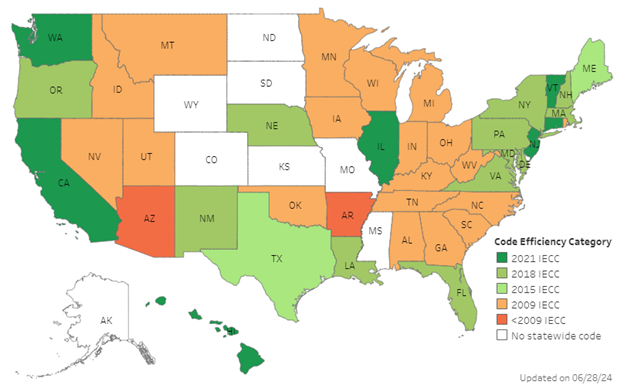Policy
Energy Codes Are Complicated: Time for a Simpler Approach?
Homebuilders can get ahead of code changes by taking advantage of incentives and participating in state code adoption processes where they build.

Builders have had to wrestle with ever-increasing energy code requirements for almost two decades. Even though the national model energy code, the International Energy Conservation Code (IECC), has increased in efficiency by about 37% between the 2006 and 2021 editions, individual states have taken longer to advance. In fact, there are only seven states that have adopted the 2021 IECC efficiency levels, and 21 states that are at or below 2009 IECC efficiency levels. Seven states don’t have any statewide code.

Will New HUD and USDA Requirements Cause Big Changes?
In April 2024, the Department of Housing and Urban Development (HUD) with the U.S. Department of Agriculture (USDA) announced that new construction homes financed by either organization are required to meet the 2021 IECC. This means that even in the 43 states that have not adopted an energy code equivalent to the 2021 IECC, builders will need to demonstrate that their homes comply with this code if a prospective homebuyer will use a HUD- or USDA-backed mortgage.
HUD also announced that it will accept the 2024 IECC or future editions of the IECC as an alternative compliance path to the 2021 IECC.
The 2024 IECC was published in August, and initial feedback is that homebuilders prefer it to the 2021 version.
A Few Key Changes in the 2024 IECC
The 2024 IECC is expected to be at least 5% more efficient than its predecessor, published in 2021. As states begin review of the 2024 edition, what can builders expect if this code is adopted?
Here’s a brief rundown of the highlights:
Building Envelope Requirements
The 2024 code returns some of the attic insulation requirements to the levels in the 2018 IECC.
|
2021 vs 2024 IECC Attic Insulation Levels |
||
|
Climate Zone |
2021 IECC |
2024 IECC |
|
0 and 1 |
R-30 |
R-30 |
|
2 and 3 |
R-49 |
R-38 |
|
4 through 8 |
R-60 |
R-48 |
The 2024 code also adds three new component insulation requirements. This includes a new option for insulation entirely above the roof deck and two new requirements for heated and unheated slab insulation.
There are also more stringent envelope air leakage requirements as follows:
- Climate Zones 1 and 2: 4 ACH50
- Climate Zones 3 through 5: 3 ACH50
- Climate Zones 6 through 8: 2.5 ACH50
When using the Simulated Building Performance or Energy Rating Index (ERI) compliance paths, the maximum envelope air leakage rate is 4 ACH50 in all climate zones. This means if a builder is using the prescriptive compliance option but doesn’t meet the more stringent requirements in climate zones 3 through 8, they may have the option of using one of the performance compliance options if their home is at 4 ACH50 or less.
Additional Efficiency Requirements
Section R408 ‘Additional Efficiency Requirements’ has been significantly expanded in the 2024 IECC. This section is required when builders are using the prescriptive compliance path. Builders must achieve a minimum of 10 points with no fewer than two options. For homes greater than 5,000 square feet of conditioned area, an additional five points are required.
Builders can choose from 51 options encompassing heating, cooling, and hot water equipment, renewable energy, windows, ventilation systems, envelope leakage, lighting, appliances, and thermostats. The number of points depends on the option chosen and the climate zone.
The Simulated Building Performance and ERI compliance paths do not require builders to use the Additional Efficiency Requirements section.
Equipment Efficiency
Federal law preempts the IECC from mandating heating, cooling, and hot water equipment efficiency levels. This is one of the reasons why the Additional Efficiency Requirements section was added to the IECC in 2021. However, one big change to the 2024 IECC is the inclusion of equipment efficiency in the Simulated Building Performance compliance option.
Since the 2009 IECC, the Simulated Building Performance path has disallowed the consideration of heating, cooling, and hot water equipment in determining compliance. The ERI compliance option has always allowed equipment efficiency since it was added to the IECC in 2015. A home energy (i.e., HERS) rater is needed to demonstrate compliance with the Simulated Building Performance or ERI compliance paths.
Equipment efficiency is important because it is one of three elements necessary to achieve net-zero energy. An efficient building envelope combined with high efficiency mechanical equipment and renewable energy are necessary for any builder seeking to achieve net-zero energy performance in their homes.
Will the IECC ever achieve net-zero energy?
The goal of many energy efficiency advocates is an energy code that achieves net-zero energy—a home that produces as much energy as it uses annually. Earlier this year, the U.S. Department of Energy released a “National Definition of a Zero Emissions Building.” Although zero emissions and zero energy are not the same, the push toward more energy- and carbon-efficient buildings is significant.
The IECC has been slowly moving in this direction through changes within the body of the code and in voluntary appendices. Some of these changes include:
- The addition of a “solar ready” appendix that has been in the IECC since the 2015 version. This is important because homebuilders can’t get to net-zero without renewable energy.
- The addition of a net-zero energy appendix in the 2021 and 2024 versions of the IECC. This appendix utilizes the ERI compliance path—the only compliance option capable of demonstrating net-zero energy.
The IECC needs to achieve approximately 20% to 30% more efficiency to achieve a net-zero energy home, with the addition of renewable energy.
Some homebuilders aren’t waiting for code changes to force their hand. For example, Beazer Homes in 2020 announced that it was the first national homebuilder to publicly commit that by the end of 2025, every new home they start will meet the requirements of DOE’s Zero Energy Ready Home (ZERH) program. Not only does this ensure the company will be above-code in every state in which it builds, but it can also earn up to $5,000 in federal tax credits for every ZERH-certified home it builds through 2032.
Getting Ahead of Energy Codes
Beazer Homes’ commitment to ZERH is a good example of getting ahead of energy code changes at the state and local levels and capturing incentives along the way. Federal tax credits are available for builders of homes that are certified to Energy Star or ZERH. Energy Star brings in tax credits of up to $2,500 per home and ZERH up to $5,000 per home.
All new homes sold or leased on or after Jan. 1, 2025, will be required to meet Energy Star version 3.2 to achieve the 45L energy efficient new-home tax credit. This version of Energy Star is based on the 2021 IECC envelope values and is a prerequisite for earning ZERH version 2 certification. Certifying a home to Energy Star v3.2 not only makes the home eligible for a $2,500 tax credit, but also ensures that it meets the new HUD and USDA mortgage requirements that take effect in November 2025.
For builders already using a HERS Rater to demonstrate energy code compliance through the Simulated Building Performance or ERI compliance options, determining whether a home is eligible for Energy Star or ZERH certification is fairly easy. Determination of eligibility for certification can be done by a HERS Rater using accredited energy modeling software—the same software used for energy code compliance.
If you’re not ready for an above-code program, continue reading for ways to simplify energy code compliance while still achieving an energy-efficient home.
Is the IECC Too complicated?
One of the first widely used residential energy codes was the 2006 IECC. The primary residential provisions in that edition of the code were four pages long. The 2024 IECC residential provisions are over 30 pages. One of the main reasons for this expansion in the IECC is the prescriptive compliance path.
The prescriptive path is considered the most expensive way to comply with the IECC because it allows builder’s little flexibility in how their designs achieve compliance. Although the Additional Efficiency Requirements section of the 2024 IECC may enable the prescriptive compliance path to get close to net-zero performance, it’s getting complicated.
There are better options that give builders freedom in how they meet energy code requirements while still building homes that save energy.
A Better Path for Energy Code Advancement
When states and jurisdictions propose the adoption of a new energy code it often turns into a battle over prescriptive requirements, like wall, ceiling, and slab insulation levels. Battles rage over the cost of these increased requirements against the anticipated payback period for the homeowner. Often the term “affordable” housing takes on many different meanings.
Is the home affordable to purchase and affordable to operate? What’s an acceptable cost to operate versus the increased cost to build? These are difficult questions. When a homebuyer is priced out of the new-home market, they are often left renting or purchasing an older energy inefficient home with much higher energy costs than a mediocre new home.
Can the energy code ignite innovation, improve purchase and operational affordability, and still achieve energy savings?
If the goal of the energy code is to reduce energy consumption in new homes, why not utilize a compliance option based on whole-house performance where the goal is an energy efficiency target, and the path to get there is up to the homebuilder?
Furthermore, why should there be battles over code adoption every three, six, or 10 years? Why can’t states or jurisdictions set target scores into the future and give builders and product manufacturers advanced notice of when they will need to meet higher levels of efficiency? Doing so would allow innovation in the design of more efficient homes.
The Texas Example
In 2021, the Texas Legislature adopted House Bill 3215, which updated the state’s universal energy code compliance pathway to allow builders to use the HERS Index (in addition to 2018 IECC envelope backstops) for energy code compliance across the state, in lieu of the state energy code or any stretch code adopted by municipalities.
The figure below shows the HERS Index target scores for each climate zone in Texas and the effective dates.

This serves as a good example of how states can simplify their energy code while ensuring increases in efficiency into the future. It also ensures third-party verification of efficiency through pre-drywall and final inspections, along with duct and envelope leakage testing. It also promotes healthy competition among builders who can use HERS Index scores in their marketing materials. It’s certainly more meaningful than telling your prospective homebuyer that your home “complies with the energy code.”
What do these target scores reflect?
Homes rated on the HERS Index scale typically score between zero and 100, where a 100 reflects a home built in compliance with the 2006 IECC and federal equipment efficiency standards in effect at that time. Each one point reduction on the HERS Index is a 1% reduction in energy consumption. The target scores currently in effect in Texas would result in homes approximately 37% to 41% more efficient than the 2006 IECC. As mentioned at the beginning of this article, the IECC has improved approximately 37% in efficiency between the 2006 and 2021 editions.
Final Thoughts
The IECC continues to improve the efficiency of new homes, but the prescriptive compliance path is not well suited to achieving net-zero energy. Builders can get involved with their state’s code adoption process and push for a simplified approach that allows them to meet efficiency targets while maintaining both purchase and operational affordability. Using a performance-based approach to energy code compliance also enables builders to see if their homes qualify for Energy Star and ZERH certification and up to $5,000 in tax credits.
MORE IN Policy
Texas Treads A New Path Into Zoning To Battle Housing Crisis
Texas is one of the nation's most active homebuilding states, yet affordability slips out of reach for millions. Lawmakers now aim to rewire the state’s zoning laws to boost supply, speed up approvals, and limit local obstruction. We unpack three key bills and the stakes behind them.
Together On Fixing Housing: Solve Two, Start the Rest
NAHB Chief Economist Robert Dietz and Lennar Mortgage President Laura Escobar argue that the housing crisis won’t be solved by magic. It starts with a unified focus on two or three priorities—a rallying cry for builders, developers, lenders, and policy-makers.
Zone Offense: North Carolina Moves To Fast-Track By Right Housing
North Carolina legislators are pushing a bipartisan bill that could fast-track housing where people need it most: near jobs and transit. Richard Lawson breaks down what it means, how it compares to other states’ moves, and why developers are watching closely.
